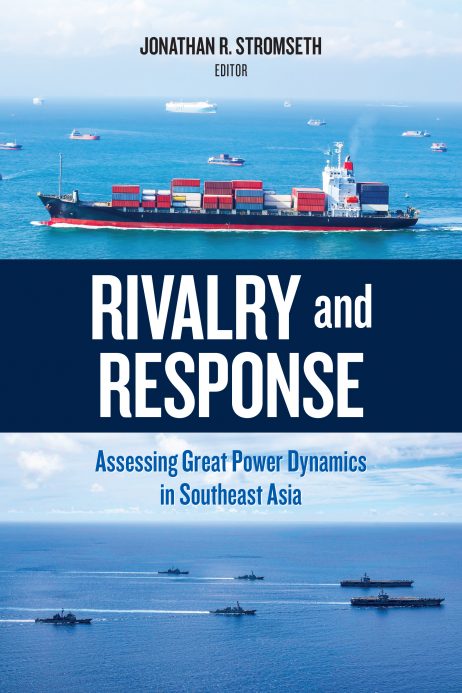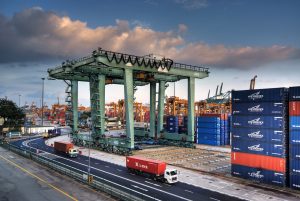Over the past decade, Southeast Asia has found itself the subject of an increasingly heated strategic competition between the United States and China, two powers with which the nations of the region retain deep security and economic ties. A new edited volume, “Rivalry and Response: Assessing Great Power Dynamics in Southeast Asia,” examines various aspects of this burgeoning Sino-American competition, from the region’s response to China’s Belt and Road Initiative to the implications of its recent authoritarian turn.
In this interview, the book’s editor Jonathan Stromseth, Lee Kuan Yew Chair in Southeast Asian Studies at the Brookings Institution in Washington, D.C., talks with The Diplomat about what Southeast Asian nations want from the United States, the role of the Quad in Southeast Asia, and how the Biden administration should best engage the region.
In this time of increasing strategic rivalry between China and the United States, the mantra that one often hears from Southeast Asian states is that they don’t want to be forced to make a choice between China and the United States. Do you agree with this framing, and what are the implications for U.S. policy toward the region?
There is a diversity of responses among Southeast Asian countries both to China’s rise and to the intensification of great power rivalry in the region, as individual states seek to manage relations with Beijing and Washington in different ways – depending on geography, economic opportunity, threat perceptions, historical experience, and other factors. In general, however, ASEAN governments prefer to have constructive relations with both the United States and China. While they appreciate the U.S. contribution to regional security, they also recognize that China is currently the largest growth engine of the world economy, accounting for nearly 30 percent of global growth. ASEAN policymakers will be clear-eyed about these economic realities as they look to the future, estimate China’s economic footprint, and calculate their likely interdependencies and opportunities with Beijing.
In this context, the U.S. should stand up to China when it violates international law in the South China Sea or threatens democracy in Hong Kong and elsewhere. At the same time, Washington should engage ASEAN countries on their own terms based on a positive economic and political agenda, rather than approaching them simply as derivative of U.S. competition with Beijing. That is the most effective way for the U.S. to compete with China in the region, while remaining a Pacific power that is respected and influential in Southeast Asia and beyond.
What advice would you give the new administration on how best to engage Southeast Asian nations over the next four years?
The Biden administration needs to improve America’s economic game in Southeast Asia in coordination with allies and partners. As U.S.-China rivalry has escalated, Beijing is increasingly achieving its strategic goals in the region through economic statecraft, as illustrated by its Belt and Road Initiative (BRI) and proactive role in forming the new Regional Comprehensive Economic Partnership (RCEP), the mega trade deal that is expected to accelerate ASEAN’s economic integration with China. The COVID-19 pandemic has only increased the policy challenges for Washington as China has recovered faster from the outbreak, reinforcing its already advantaged economic position.
In this connection, one of the key findings of “Rivalry and Response” is that U.S. policy has become too concentrated on defense and security, to the detriment of diplomacy and development, allowing China to fill the soft power vacuum and capture the narrative through BRI. Security concerns still matter, to be sure, but Southeast Asian countries tend to prioritize economic development because it is the immediate pain point for most of them.
Although returning to the TPP family would be politically difficult given American skepticism of globalization and free trade deals, the option should be explored by examining the costs and benefits for American workers and identifying possible areas of renegotiation – including on labor and environmental issues. The Biden administration should also accelerate infrastructure coordination by operationalizing existing platforms, such as the 2019 Japan-U.S. Mekong Power Partnership and the 2018 Trilateral Partnership for Infrastructure Investment in the Indo-Pacific with Japan and Australia. Few concrete projects have resulted from these initiatives thus far. The administration should make them a reality and accelerate investments and loans, especially in the Mekong subregion where Chinese economic influence is growing so fast. The objective shouldn’t be to confront BRI and create a bifurcated region, but to develop compelling alternatives and then reengage China from a position of strength.
How might the U.S. engage or cooperate with China in the region?
The Biden administration has framed its approach to China as competitive when it should be, collaborative when it can be, and adversarial when it must be. Areas for possible collaboration include global governance challenges where the U.S. and China have overlapping interests, like climate change, as witnessed in climate envoy John Kerry’s recent visit to Shanghai, when Washington and Beijing agreed to fight climate change “with the seriousness and urgency that it demands.” Moving forward, the administration should consider engaging Beijing to help combat climate change in Southeast Asia, a maritime region that is particularly vulnerable to global warming. For instance, it could work with Beijing to establish a multi-donor trust fund at the World Bank, to which third countries could apply for climate support, or simply encourage co-financing from regional development banks to address this issue. Such initiatives would send a reassuring signal that U.S.-China cooperation is possible, even in a region widely seen as the epicenter of their geopolitical rivalry.
 Evan Feigenbaum of the Carnegie Endowment for International Peace argued recently that the U.S. has historically funneled its Asia policy through its China policy, but that it needs to get Asia right before it can get China right. Do you agree? And if so, how do you think it might best do this?
Evan Feigenbaum of the Carnegie Endowment for International Peace argued recently that the U.S. has historically funneled its Asia policy through its China policy, but that it needs to get Asia right before it can get China right. Do you agree? And if so, how do you think it might best do this?
I agree that the best China policy is a strong Asia policy. The Biden administration is taking steps in this direction by reengaging allies, especially in Northeast Asia, and by working with Japan, Australia, and India to expand the Quad beyond security to include a new vaccine partnership as well as working groups on climate change and emerging technologies. In this new framing, the Quad is not just a grouping of democracies with shared concerns about China, but a potential source of public goods for Southeast Asia and the broader Indo-Pacific. The hitch is that most ASEAN nations remain suspicious of the Quad, seeing it as a challenge to ASEAN Centrality and possibly a destabilizing counterweight to China in the region. Still, there appears to be a growing recognition that the Quad is here to stay, and the new focus on vaccines and climate is generally welcomed. ASEAN would likely be more welcoming if the Quad did more in the economic realm, especially on infrastructure. A critical question is whether the Quad and ASEAN can cooperate in the provision of these public goods.
Meanwhile, Chinese diplomacy has gone into hyperdrive to counter the Quad. China’s top diplomats have met their ASEAN counterparts at least 21 times since August 2020, holding more face-to-face meetings at this level than all four Quad countries combined. China is also “socializing” with ASEAN countries to an increasing degree, sending a continuous flow of missions and groups to the region. The Chinese are in listening mode compared to five years ago, as discussed in “Rivalry and Response,” even contracting local think tanks to conduct studies on BRI implementation experiences, warts and all.
At the same time, China faces its own limitations and trip wires in the region – including growing distrust of its strategic intentions according to the latest ISEAS-Yusof Ishak Institute survey of Southeast Asian policy elites. China’s impact on domestic governance trends can be overstated as well. Beijing may be reinforcing authoritarian trends by exporting surveillance technology or exemplifying a political model that appeals to authoritarian leaders, but it is important to weigh these factors against deeply rooted historical drivers in the countries themselves. We can see this in the recent military coup in Myanmar, where the political role of the Burmese military has been institutionalized over many decades and probably exceeds that of the Indonesian military under Suharto. The military also has longstanding suspicions about Chinese influence in the country. It is critical to keep these internal drivers in mind when considering the impact of U.S.-China rivalry on domestic politics in Southeast Asia, or the likely effects of U.S. foreign policy initiatives more specifically.
Apart from multilateral initiatives like the Quad, how do you see bilateral ties evolving between the U.S. and countries in the region?
Compared to alliance relations with Thailand and the Philippines, there is more upside for the U.S. in deepening ties with emerging partners like Vietnam. U.S. relations with Vietnam have expanded considerably in recent years owing to growing trade ties, strong people-to-people relations, and a common concern over China’s actions in the South China Sea and its increasing economic and political influence in mainland Southeast Asia. Highlights include the establishment of a “comprehensive partnership” in 2013 and the dramatic visit of a U.S. aircraft carrier to Danang in 2018. Last year, the U.S. Centers for Disease Control and Prevention also announced plans to open a regional office in Hanoi to increase public health engagement in Southeast Asia. It may soon be time to take the next step, elevating U.S.-Vietnam relations to a formal strategic partnership.
Jonathan Stromseth is a senior fellow and Lee Kuan Yew Chair at the Brookings Institution. He previously served on the secretary of state’s policy planning staff, focusing on China and Southeast Asia, and was The Asia Foundation’s country representative in Beijing and Hanoi. For more information on his new edited book, “Rivalry and Response: Assessing Great Power Dynamics in Southeast Asia,” see here.

































